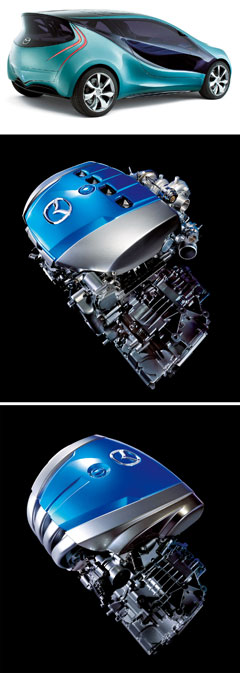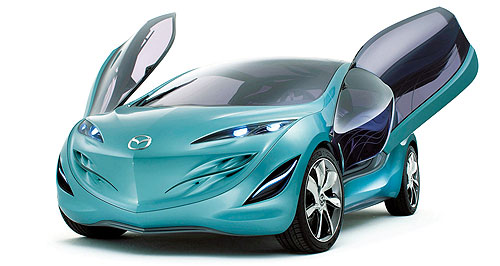Make / Model Search
Future models - Mazda - KiyoraTokyo show: Mazda heads sky-highMazda miser: The Mazda Kiyora concept uses a new-generation direct-injection petrol engine to achieve just 3.1L/100km fuel consumption. New direct-injection petrol and diesel engines for next-gen Mazda2 here from 201223 Oct 2009 By MARTON PETTENDY in TOKYO MAZDA used this week’s Tokyo motor show to present the first tangible evidence of its commitment to reduce the fuel consumption of its new model fleet by 30 per cent over 2008 levels by 2015. While other car-makers have hitched their future automotive technology wagons to either hybrid power, such as Toyota, or all-electric drive systems, such as Nissan, Mazda continues to pledge it will deliver a greater total reduction in fuel consumption and CO2 emissions through the widespread deployment of lighter-weight and more affordable vehicles powered by highly efficient new conventional internal combustion engines. The first of these is expected to be the next generation of the company’s smallest model, the Mazda2, in 2011, when Mazda has promised to begin the rollout of a new range of ‘Sky’ direct-injection petrol and diesel engines. Publicly debuting at Tokyo in the “near future” Kiyora concept car, which emerged at last October’s Paris motor show, the first example is a 1.3-litre DI petrol four. Mated to Mazda’s new ‘Sky-Drive’ six-speed automatic transmission in the latest B-segment sized Kiyora, the smallest iteration of the new-generation ‘Sky-G’ petrol engines returns Prius hybrid-shaming average fuel consumption of just 3.1L/100km, as well as sub-90g/km CO2 emissions.  From top: Mazda Kiyora Concept, Mazda SKY-D diesel, Mazda SKY-G petrol. From top: Mazda Kiyora Concept, Mazda SKY-D diesel, Mazda SKY-G petrol.While the replacement for the current Mazda2, which was released in Australia in September 2007 and is the oldest model in Mazda’s mainstream passenger car line-up, is unlikely to match that figure, Mazda has committed to reducing the weight of its next-generation models by an average of 100kg. In the case of the Two, that represents a substantial 10 per cent weight-saving and, as with the mid-sized Mazda6 range (launched here in February 2008) and small Mazda3 line-up (released locally in April this year), would make it the lightest in its class. The repowered Kiyora concept also features regenerative braking technology, which recovers normally wasted kinetic energy from the car’s braking system and returns it to the battery, and Mazda’s unique ‘i-stop’ idle-stop system, which doesn’t employ a starter motor like other similar systems but cleverly stops the engine at a point at which only spark is required to restart it. Both systems will be progressively added to new Mazda models from 2011, when the next Mazda2 is likely to emerge globally before its release here in 2012, meaning that the new Sky engines alone will deliver the lion’s share of Mazda’s planned fuel and CO2 reductions. Representing a new direction after saying it would not enter the hybrid or EV race in the foreseeable future, Mazda says both technologies are also compatible with hybrid and plug-in hybrid drive systems, for which it recently announced a $3.7 billion R&D investment. However, Mazda continues to insist it will offer a greater and more immediate impact on global warming with conventional new engines rather than hybrids, which it says currently comprise just two per cent of vehicles globally. “The remaining 98 per cent is the market we want to focus on for now,” said Mazda president Takashi Yamanouchi in Tokyo this week. Mazda says hybrid and electric vehicle battery costs, the limited range of EVs and the lack of EV recharging infrastructure will see internal combustion engine vehicles continue to play a major role globally for some time. “When the market changes we will be there to follow those changes,” said Mr Yamanouchi, who said Mazda would introduce its first hybrid vehicle “in the early part of next decade”, followed by electric or hydrogen-powered zero-emissions vehicles. “We do have electric vehicle technology. EVs will never replace all forms of transportation. They will be limited to congested areas. “Mazda will first work to enhance its base technology. We feel that by doing this we will be able to offer better fuel efficiency to everyone, not just to selected customers. “We want to ensure that we respond effectively as we can when the public demand trend slowly shifts.” While the 1.3-litre Sky-G petrol engine in the Kiyora at Tokyo could replace the current Mazda2’s standard 1.5-litre engine, Mazda says the 2.0-litre version delivers 15 per cent better fuel economy and torque output than its current 2.0-litre petrol engine, putting it on par with the Mazda6’s latest 2.2-litre diesel engine, which should become available in the Mazda3 early next year. The Sky-D clean-diesel engine range is claimed to be even more efficient, reducing fuel consumption 20 per cent, while increasing torque across the range. The Sky-Drive automatic, meantime, is said to improve fuel economy by five per cent, while Mazda says i-stop reduces fuel consumption by 15 per cent.  Read moreAll future models Alfa Romeo Alfa Romeo Abarth Abarth Alpine Alpine Alpina Alpina Audi Audi Aston Martin Aston Martin BMW BMW Bentley Bentley Chery Chery Brabham Brabham Chrysler Chrysler Chevrolet Chevrolet Cupra Cupra Citroen Citroen DS DS Dodge Dodge Fiat Fiat Ferrari Ferrari Foton Foton Ford Ford Great Wall Great Wall FPV FPV Haval Haval GWM GWM Honda Honda Holden Holden Hummer Hummer HSV HSV Infiniti Infiniti Hyundai Hyundai Jaguar Jaguar Isuzu Isuzu Kia Kia Jeep Jeep Land Rover Land Rover Lamborghini Lamborghini Lexus Lexus LDV LDV Mahindra Mahindra Lotus Lotus Mazda Mazda Maserati Maserati Mercedes-AMG Mercedes-AMG McLaren McLaren MG MG Mercedes-Benz Mercedes-Benz Mitsubishi Mitsubishi Mini Mini Opel Opel Nissan Nissan Peugeot Peugeot Pagani Pagani Proton Proton Porsche Porsche Renault Renault Ram Ram Rover Rover Rolls-Royce Rolls-Royce Skoda Skoda Saab Saab SsangYong SsangYong Smart Smart Suzuki Suzuki Subaru Subaru Toyota Toyota Tesla Tesla Volvo VolvoMotor industry news |
Click to shareMazda modelsResearch Mazda All future models Alfa Romeo Alfa Romeo Abarth Abarth Alpine Alpine Alpina Alpina Audi Audi Aston Martin Aston Martin BMW BMW Bentley Bentley Chery Chery Brabham Brabham Chrysler Chrysler Chevrolet Chevrolet Cupra Cupra Citroen Citroen DS DS Dodge Dodge Fiat Fiat Ferrari Ferrari Foton Foton Ford Ford Great Wall Great Wall FPV FPV Haval Haval GWM GWM Honda Honda Holden Holden Hummer Hummer HSV HSV Infiniti Infiniti Hyundai Hyundai Jaguar Jaguar Isuzu Isuzu Kia Kia Jeep Jeep Land Rover Land Rover Lamborghini Lamborghini Lexus Lexus LDV LDV Mahindra Mahindra Lotus Lotus Mazda Mazda Maserati Maserati Mercedes-AMG Mercedes-AMG McLaren McLaren MG MG Mercedes-Benz Mercedes-Benz Mitsubishi Mitsubishi Mini Mini Opel Opel Nissan Nissan Peugeot Peugeot Pagani Pagani Proton Proton Porsche Porsche Renault Renault Ram Ram Rover Rover Rolls-Royce Rolls-Royce Skoda Skoda Saab Saab SsangYong SsangYong Smart Smart Suzuki Suzuki Subaru Subaru Toyota Toyota Tesla Tesla Volvo VolvoMotor industry news |











Facebook Twitter Instagram